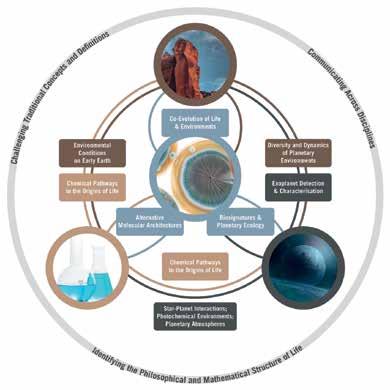
21 minute read
A New Centre Lays the Ground for Big Questions about Life in the Universe
A New Centre Lays the Groundwork for Big Questions about Life in the Universe By Paul B Rimmer (2020)
We don’t know how life originated on Earth. We don’t know if there is life elsewhere in the universe. Both of these statements are true today. There is a good chance that neither of these statements will be true in the coming decades. This is not a coincidence, because both of these claims about our ignorance are connected. If it is very hard for life to originate on Earth or anywhere else in our universe, then we may expect that life will be very rare, and we may not discover signs of life on rocky planets around nearby stars. On the other hand, if signs of life are found on one or more of these planets, this will suggest that there must be some way for life to emerge that is fairly robust and probable, at least over geological periods of time. Recent developments in planetary science, exoplanetary astronomy and prebiotic chemistry have revealed connections that were not obvious beforehand, and that provide a path toward answering the questions: How did life originate on Earth? Are we alone in the universe? These questions will be confronted by a coordinated effort across several disciplines, the three named above and also biology, mathematics, arts and humanities.
This multidisciplinary ecosystem will find support in a new Leverhulme Research Centre at Cambridge: The Leverhulme Centre for Life in the Universe (LCLU). Figure 1 provides an illustration of the structure of the Centre and its component disciplines. The story of the aims of the centre and the work by the people affiliated with the centre, can be told in a variety of ways, with a variety of starting-points. Here, I will tell the story with prebiotic chemistry as the starting point.
Chemistry at the Start of Life’s Origins Recent breakthroughs in prebiotic chemistry, several of them coming from the group of Trinity Fellow John Sutherland, have for the first time given us insight into plausible first steps from simple molecules to the building blocks of DNA and RNA, proteins and membranes. These ‘lego blocks’ of life as we know it can be formed together, along with other molecules that can help them interact productively, before life was there to provide enzymes to facilitate these interactions.
FEATURES Figure 1: Schematic representation of the structure of the Leverhulme Centre for Life in the Universe. Earth Sciences, Astronomy and Chemistry all interact to provide a chemical, geological and (exo)planetary context for possible origins and evolution of life in the universe. One goal is to identify predictive consequences of the connections between these fields that can help constrain how life could have originated and evolved on Earth and other planets, and can test these predictions based on observations of Earth, other planets in our solar system, and the atmospheres and eventually surfaces of rocky exoplanets. Arts and humanities provide an enveloping framework, exploring the ways these fields communicate with each other and the social, philosophical and religious implications of their results.
The discovery of a way to produce these molecules simultaneously fits well with a trait of molecular biology: that components of cells, which are often distinguished from one another conceptually, are in fact not separate at all. When looking at the molecular entities which constitute the major components of a cell, we tend to think of proteins as controlling chemical reactions, RNA and DNA as storing and copying genetic information, membranes as holding the cell together. But consider the ribosome, which takes three-nucleotide-long sequences of RNA and matches them to a specific amino acid, facilitating the
translation of the information stored in DNA into functional proteins that regulate the chemistry in the cell. The ribosome is made of a combination of RNA and proteins. The cell membrane’s function is to encapsulate the cell, while allowing the expulsion of waste and the formation of energetic gradients, achieved by embedding proteins into its makeup. Everything is connected in ways that appear to be essential, so that not one structure could have originated without the others. The developing prebiotic scenario provides the building blocks for all these molecules in the same environment.
A Geochemical Cradle for Life The cyanosulphidic scenario can be connected with a variety of geochemical contexts and environments (see Sasselov et al. 2020). It is called the cyanosulphidic scenario because it starts with hydrogen cyanide (HCN) and hydrogen sulphide (H2S). In environments where these molecules are present in water, maybe with some other molecules and ions such as bisulphite (SO3 2-), ferrous iron (Fe2+), phosphate (PO4 3-), and nitrate (NO3 -), and irradiated with ultraviolet (UV) light, they can form simple sugars that eventually, depending on the specific geochemical environment, can lead to some or all the building blocks mentioned above. A scheme for the first few steps is shown in Figure 2.
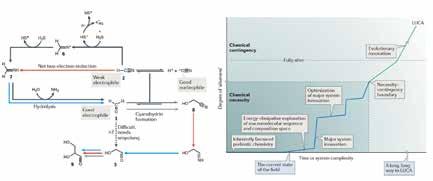
Figure 2: (Left) A chemical scheme for the net two-electron reduction of hydrogen cyanide. These are the first steps for taking hydrogen cyanide (HCN) and hydrogen sulphide (H2S) in water, often buffered by phosphate, exposing the mixture to UV light, and producing simple sugars that can react with other molecules to form amino acids, nucleotides, and phospholipids, several of the building blocks for RNA and DNA, proteins, and cell membranes. (Right) A conceptual plot of “Aliveness” as a function of system complexity (or time), showing the progression of a system from definitively not alive (single-carbon geochemically reasonable molecules) to definitively alive (LUCA), suggesting that the concept of what is alive may not be binary, but may be a continuum, with several shallow and steep transitions. Adapted from Sutherland (2017) with permission of the author.
Not all of this chemistry can happen in the same place and at the same time. It is important that there are differences in chemical environments over short distances. The presence of these molecules and ions, and the diversity and variation of local regions within a single environment are all expected in many surface environments on ancient Earth and Mars. Earth has lost much of its ancient history due to its active hydrological cycle, plate tectonics and the alteration and destruction of rocks by life. Mars’s history is much better preserved. The Jezero Crater in particular is an environment that likely satisfied all the molecular and diversity conditions when it was young, and NASA’s Perseverance Mars Rover is going to search for evidence of this chemistry. Earth Science Professor Nicholas Tosca is affiliated with this mission, and is investigating the potential connection between Jezero Crater environments and the cyanosulphidic scenario, using laboratory experiments, geochemical models and eventually observations by the Perseverance Rover itself. This is just one example of an investigation into possible geochemical ‘cradles of life’, a fruitful intersection between biology, Earth and planetary sciences and prebiotic chemistry.
Life Illuminated by Other Stars Another promising intersection is starlight. The cyanosulphidic scenario needs ultraviolet light for the reactions starting with HCN and H2S and SO3 2-. Because these molecules and their products are not stable forever, it is important to have enough ultraviolet light for the productive chemistry to build up. Starlight is also the property of exoplanet systems that is best known from observations. Some work has already been undertaken by John Sutherland in collaboration with another Trinity Fellow, Didier Queloz, and with me. We found out how to compare the light used in the laboratory to the light from different stars to predict where the cyanosulphidic chemistry has the best chance of happening. There is a whole world of chemistry to explore using light in the lab the mimics the suns of different alien worlds. Similar to the search for prebiotic chemistry on Mars as a test as to whether this chemistry happens in other places, we can look toward exoplanets to find out if the starlight is sufficient for these reactions.
The Nature of Life Itself The possible discovery of signs of life on alien worlds may well be the only way empirically to test different origins of life scenarios, such as the cyanosulphidic scenario, so long as the scenarios are connected in some essential way to
properties of an exoplanet system that can be constrained by observations. There is real potential to use distributions of biosignatures in order to test origins scenarios. Doing so will require a more fundamental understanding of life as we know it. We can apply this understanding to alien environments, and the activity of life in those environments. This is especially true because prebiotic chemistry is still very far away from producing a living system in the lab. Even if a prebiotic chemical scenario, such as the cyanosulphidic scenario, could make life, it is not guaranteed that the life would take hold of its planetary environment in a way that would produce detectable changes in the planet’s surface or atmospheric composition. Biologists, geologists, chemists and astronomers will need to work together in order to explore these and many other connections. The interaction between so many disciplines can be challenging, because these disciplines speak different languages, have different goals and subtle differences in standards of evidence, and draw different implications and meanings from new discoveries. The involvement of the Arts & Humanities (A&H), especially at these interfaces, can be mutually enriching. Scientists help A&H scholars keep up-to-date with the science they think about according to their own interdisciplinary methods, and A&H scholars offer scientists ways to look at topics from new angles, drawing on the long traditions they inhabit of examining concepts. The Leverhulme Centre for Life in the Universe (LCLU) facilitates connections between fields and provides support for research that spans multiple disciplines, directed toward the dual goals of the search for life elsewhere in the universe, and the search for its origins here on Earth. The support is centered at Cambridge as a ‘hub’, with ‘spokes’ at ETH Zurich, Princeton, University of Colorado, Harvard and University College London!
A Panoply of Projects Now that I’ve given a broad overview of what the LCLU is for, I will turn to what people connected to the Centre are doing. I talked about some of the motivations and goals of the Centre by telling a story. There would be many different ways to tell the same story, starting from astronomy, or Earth sciences, or religion, or poetry. Likewise, there are so many things going on at Cambridge connected to the LCLU that I cannot cover them all here. What will follow are a few samples of what people are working on. If readers are interested in finding out more, I recommend visiting the LCLU website (https://www.lclu.cam.ac.uk/)
Life on Earth and (maybe not) in the Clouds of Venus A lot of work to link prebiotic chemistry to the search for life on exoplanets centers around biosignatures, and almost all claimed biosignatures are based on our understanding of life, and involve unsolved mysteries about life on Earth, such as the origin of oxygenic photosynthesis, the great oxygenation event: when Earth’s atmosphere quite suddenly became much more oxygen-rich, the origin of Eukaryotes, and the origin of animal life. Researchers at Cambridge are working on each of these fundamental transitions of life and its environment.
In the case of animal life, its origins can be studied by examining fossils in the Ediacaran Period. This period of geological time comes right before the Cambrian, and spans 635 million years ago to 538.8 million years ago. In general, the fossils at this time look very different to those in the Cambrian and after, and so new techniques are needed to use the fossils we have to understand what the animals looked like, and how they lived. Dr Emily Mitchell, a new assistant professor in Zoology at Cambridge, has developed remarkable techniques to do just this, involving computer science and laser-scanners and maths.
Figure 3 shows a reconstruction by Dr Charlotte Kenchington (Earth Sciences) of the Mistaken Point E surface, making use of some of these techniques. Drs Mitchell and Kenchington take a laser scan the fossil surfaces to a 40 micron resolution.
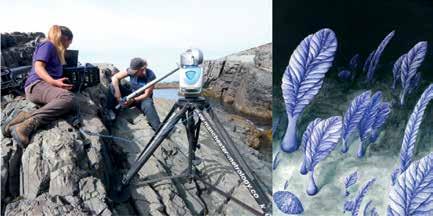
Figure 3: (Left) Dr Emily Mitchell (Zoology) laser-scanning fossils in Mistaken Point with Dr Lucy Roberts (Zoology), photograph by Dr Charlotte Kenchington (Earth). They laser scan the fossil surfaces to 40 micron resolution. It takes around 1 hour to scan 1 m2 of surface. (Right) A reconstruction by Dr Charlotte Kenchington (Earth) of a Mistaken Point community, made using the life-history information gained from the 3D laser-scans.
It takes around 1 hour to scan 1 m2 (a video of https://www.deeptimeecology. org/ediacaran-fossils.html). These scans capture the entire surface, from which a map is made of where the fossils are, what species they are and how big they are. Because these animals couldn’t move, their position and size on the rock surface encapsulates their entire life-histories – how they reproduce, interact with each other and their environment. Dr Mitchell then uses spatial analyses to on the spatial patterns to reverse-engineer these traits. These sort of analyses have enabled her to investigate the drivers of early animal evolution, finding, in stark contrast to our modern world, a remarkable lack of interaction with their environment. This work suggests that early animal evolution may not have been driven by systematic adaptations to the local environment, but instead may have resulted from random differences within their populations. The reconstruction shows the community of Ediacaran organisms called rangeomorphs, with the spatial positions in the painting based on the reproductive, interaction and environmental traits they found using their analyses.
Speculation about the atmospheric signatures of life on worlds very different from Earth is most useful when it can lead to testable predictions, and this is easiest to do for planets closest to home, such as Mars and Venus. The tentative detection of molecules unexpected in the clouds of Venus, such as ammonia and phosphine, has renewed speculation about life in the clouds. The clouds of Venus are temperate, existing at roughly the same temperature and pressure as the surface of the Earth. But the droplets likely contain large amounts of sulphuric acid, and almost certainly contain very little water. These extremes are
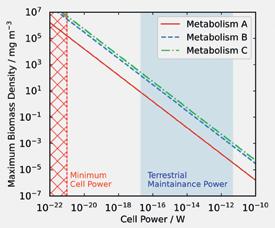
Figure 4: Work by Sean Jordan, a PhD Student at the Institute of Astronomy (supervised by Dr Oliver Shorttle), estimating the biomass in the clouds of Venus on the basis of available but unused chemical energy stored in the molecules observed in the clouds. The absence of observable products of metabolism in the clouds of Venus suggest that either there is no life in the clouds of Venus, or very little life, or life in the clouds is finding its energy and expelling its waste in ways that defy our understanding of biological energy-metabolism.
far out of the bounds of what is possible for life as we know it. These clouds may therefore provide a good place to look for life as we don’t know it. It seems that life, whatever its chemistry, would make use of available chemical energy if at all possible, and life on Earth has been known to make use of sulphur dioxide in its energy-metabolism. Sean Jordan, a PhD student at the Institute of Astronomy, advised by Dr Oliver Shorttle and me, took a look at the behaviour of sulphur dioxide and other gasses in the clouds of Venus. He found that the use of the chemical energy results in concentrations of waste products in the atmosphere that cannot be reconciled with observations. This means that, if there is life in the clouds of Venus, either there is very little (see Jordan’s constraints in Figure 4), or it is very unlike life on Earth, and is not using the available chemical energy in Venus’s atmosphere.
Prebiotic Chemistry – Two Complementary Directions John Sutherland’s group has been making fast progress since the discovery of the cyanosulphidic scenario. I will briefly summarise two breakthroughs, recently presented in two papers, involving non-enzymatic activation chemistry and a UV-driven chemistry that produces some of the intermediates of the Krebs Cycle. Both of these papers were led by MRC Laboratory of Molecular Biology postdoctoral fellow Ziwei Liu.
The building blocks of RNA, DNA and proteins are useful as building blocks because they are relatively unreactive, until they need to react. If they were reactive, the building blocks would react with the first thing they meet, and would not be useful for storing and transferring information or for the construction of reliable molecular machinery to regulate reaction rates. In living cells, the building blocks are activated (made reactive) and joined together by enzymes. Before life originated, there were no enzymes. Some other chemistry was required for this activation and joining of molecules. Ziwei and several other chemists working in the Sutherland group discovered that some of the intermediates and by-products of the cyanosulphidic chemistry could help provide just this function. 4,5-Dicyanoimidazole (a by-product of adenine synthesis using cyanide) and methyl isocyanide (a product of ferrocyanide and nitrate chemistry – closely connected to the cyanosulphidic chemistry), can activate nucleotides, amino acids and phospholipids to let them link together in the same ways they link together in a living cell. This may be the first step toward the genuine construction of proteins, RNA/DNA molecules, and protocellular membranes.
Ziwei and others in the Sutherland and Sasselov (Harvard) groups also investigated the reaction of sulphur dioxide and carbon dioxide dissolved in water: sulphite and carbonate. When exposed to UV light, these simple molecules form several of the C3 and C4 intermediates of the Krebs cycle. These molecules may help the transition from a pre-life system based on the chemical energy stored in UV and nitriles, to a system more like life as we know it, using CO2 for its carbon, and other, more mild, forms of energy than UV light. This transition also relates to the concept of “aliveness” (see Figure 2), and is the chemical basis of a project funded by the precursor to the LCLU, involving philosophers, theologians, mathematicians and scientists, to see if “aliveness” can be quantified in the context of prebiotic chemical systems.
This is one example of the interaction of Arts & Humanities and the Sciences. Other examples of this interaction would include discussions on the nature of life, matter, what constitutes an origin, how to represent degrees of uncertainty, and what qualifies as evidence for a multidisciplinary project, where strong evidence for any one field may not be considered as evidence at all in another field.
The concept of aliveness itself is connected to the search for life in the universe. As can be seen from Figure 2, the path from low to high aliveness can involve smooth or steep transitions. The steeper the transitions, the more difficult it may be for life to originate. If the transitions for the most likely path from nonlife to life are sufficiently steep, this would suggest that we may be alone in the universe. Again, I emphasize here, we don’t have any real empirical constraints for the abundance of life in the universe, apart from a single data-point: us.
Volcanism as a Source of HCN and H2S The cyanosulphidic scenario is not plausible outside environments where there is significant HCN and H2S. One set of environments that may provide these molecules are volcanic systems.
Philippa Liggins, a PhD student at Earth Sciences working with Dr Oliver Shorttle, has investigated volcanic systems using empirically-constrained models of magma chemistry, and accounting for simple atmospheric evolution, and accounting for carbon dioxide (CO2, a direct precursor to carbonate), sulphur dioxide (SO2, a direct precursor to sulphite), hydrogen sulphide (H2S) and CH4 (a photochemical precursor to HCN), among other chemical species. Her predictions, seen in Figure 5, show what kind of magma chemistry we can expect on early Earth based on the chemically available oxygen in the magma. If

Figure 5: Models of magma chemistry from Earth Sciences PhD Student Philippa Liggins (supervised by Dr Oliver Shorttle). This shows how key starting molecules for prebiotic chemistry, such as methane (CH4), carbon dioxide (CO2 ), sulphur dioxide (SO2 ) and hydrogen sulphide (H2S) behave as a function of how much chemically available oxygen there is in the magma (fO2 ). Magmas with very little available oxygen will be good for getting HCN and H2S, and magmas with more available oxygen will be good for getting SO2 and CO2 .
there is a lot of chemically available oxygen, then there is probably little volcanic CH4 and H2S, but plenty CO2 and SO2, and in this environment, we might expect the Krebs cycle precursors discussed above. This may be appropriate for many places on the surface of Mars. On the other hand, if there is little chemically available oxygen, volcanic CH4 and H2S rule, and there could be abundant HCN and H2S available to set off the cyanosulphidic scenario.
Tools to Observe and Mimic Starlight A component of the cyanosulphidic scenario mentioned several times already is ultraviolet (UV) light. The UV light used in the lab generally looks very different from starlight. At the same time, starlight is key for finding exoplanets. Two main ways to find exoplanets involve looking at the changing light of the star. Transit methods look at how the light of the star dims as the planet passes in front of the star. The time between transits gives an idea about the period of the planet. And the extent of the dimming is related to the size of the planet compared to the size of the star. Radial velocity methods involve watching the light of the star over time, and seeing how specific spectral lines shift a small amount, red to blue, suggesting the star is wobbling, moving away and toward us so slightly. The strength of this wobble indicates something about the planet’s mass, though this is folded into the star’s mass and the geometry of the system based on our vantage point. The frequency of the wobble says something about the period of the planet’s orbit, and thanks to Kepler’s third law, this indicates how far away the planet is from the star.
To detect an Earth-like planet roughly 1 AU from a Sun-like star requires a level of precision that is difficult to imagine: the equivalent of watching a line shift on a CCD across four silicon atoms, over a period of years. Yet this is just the technical and scientific challenge Didier Queloz is undertaking, as part of a large multi-national team. The construction of the spectrometer for this experiment, the Terra-Hunting Experiment (https://www.terrahunting.org/), is being undertaken by some of Prof Queloz’s postdoctoral fellows and graduate students, and several visiting scientists, at the Cavendish Laboratory. A picture of the spectrometer design can be seen in Figure 6, and is courtesy of Dr Clark Baker, a postdoc in the Queloz group.
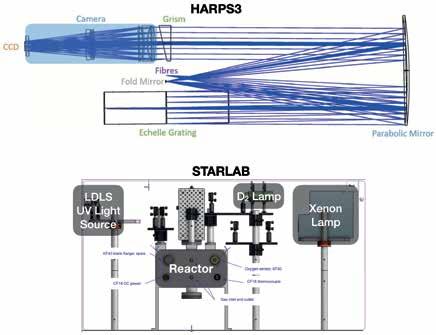
Figure 6: Two Separate experiments, two separate goals, both focused on starlight. (Top) Optical schematic for HARPS3, which will look at the doppler shifts in the frequency of light of sunlike stars to search for temperate planets orbiting those stars. Image is courtesy of Clark Baker, a postdoctoral fellow at Cavendish Laboratory working with Dr Samantha J Thompson and Prof Didier Queloz. (Bottom) A schematic for the Stellar Simulator experiment at Cavendish Laboratory under development by the group of Dr Paul B Rimmer. The combination of several broadband and discrete ultraviolet (UV) light sources will allow for the approximate reproduction of the spectral shape of any planet-hosting star. Image courtesy of King Lam, a summer student of Dr Alex Thom who spent part of his summer working on experimental designs with Dr Rimmer.
I will end this overview of activity by talking about some of my own work. As I mentioned before, the lights used in the lab for the cyanosulphidic chemistry look nothing like the light of a star. My group at Cavendish Laboratory will work on the design of a light source that can broadly mimic any main sequence star, as that light would be seen on the surface of a rocky planet. This involves the use of several broadband and a handful of discrete UV light sources, filters, and environmental controls essential for capturing important factors of surface chemical environments on exoplanets. The design can be seen in Figure 6, and is courtesy of King Lam, an exceptionally talented undergraduate student with a knack for engineering and optics.
This overview, like the story, is biased by my own interests and knowledge, and provides only a taste of what is going on at the LCLU. I should emphasize that almost all of these projects are not directly supported by the LCLU, but involve work from members of the LCLU, that have been brought together thanks to the Centre. Without the support of the Centre, I would not be aware of all this amazing interconnected work its members are currently doing. I am very excited to see where these and other projects will lead in the next ten years, especially as they inform each other.
Finally, no interdisciplinary work, no matter how small, succeeds because of the efforts of a single person. That includes the writing of this article. I am grateful for the contributions of Andrew Davison (Divinity), Emily Mitchell (Zoology), Oliver Shorttle (Earth Sciences, Institute of Astronomy) and Nicholas Tosca (Earth Sciences).









